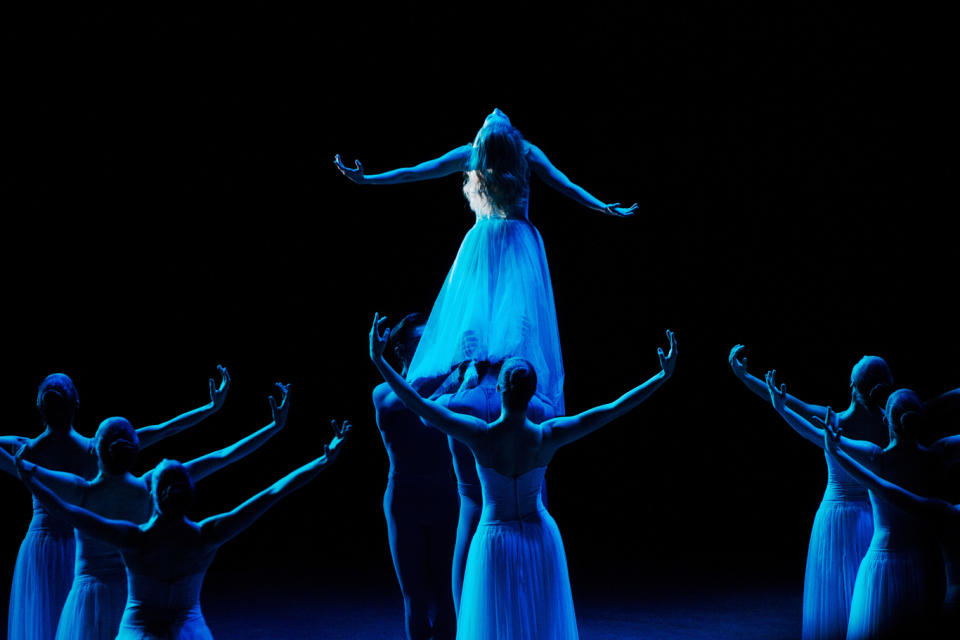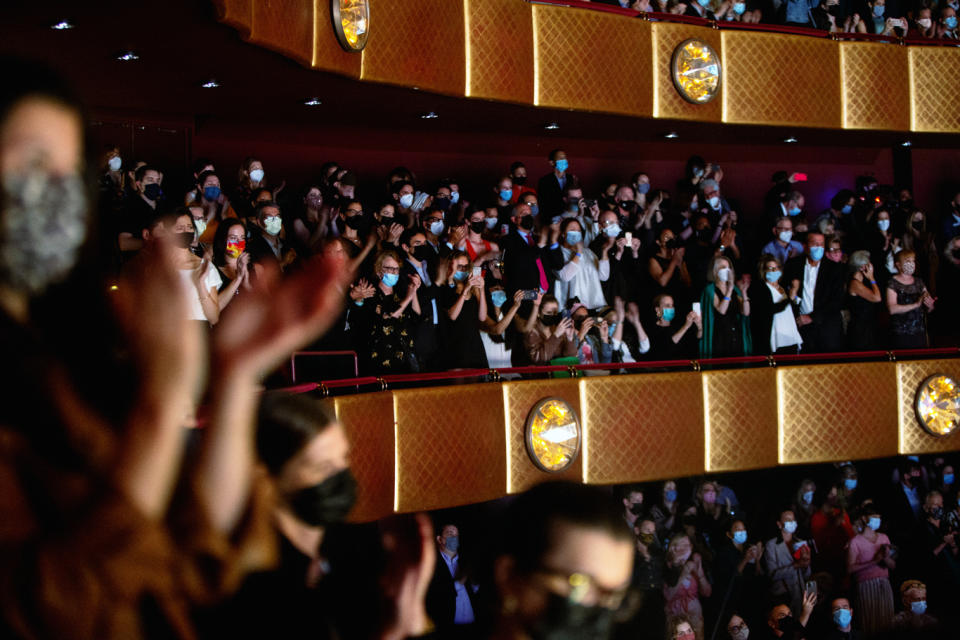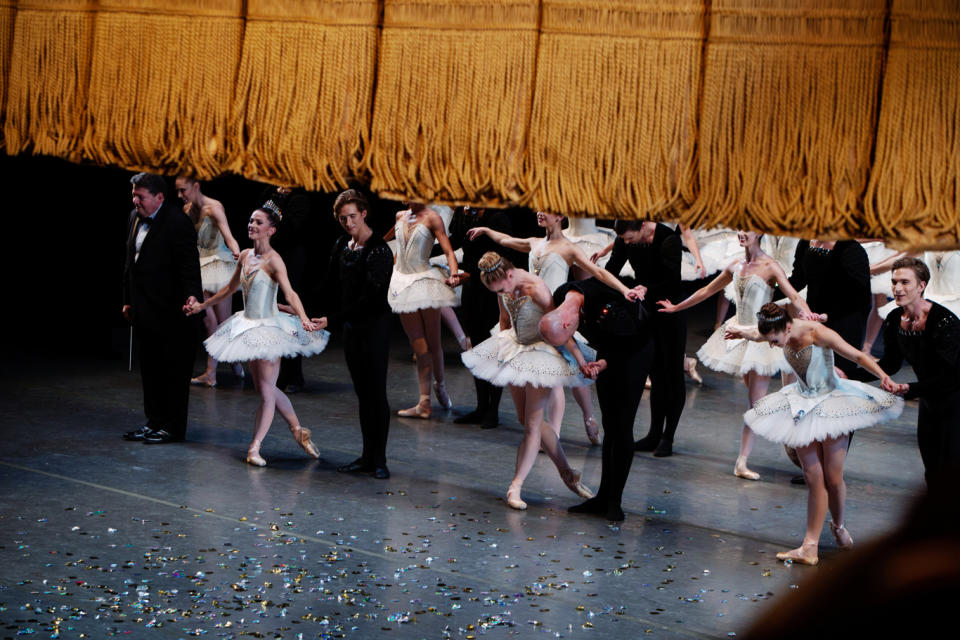New York City Ballet Makes Historic Return to the Stage After Pandemic

It was like a capsule of time, a scene from another era, had come back to meet us on the other side.
Entering Lincoln Center’s limestone halls again was a New York mix of young and old — seasoned opera buffs and young women ironically wearing elbow-length opera gloves, men in baseball caps and women whose heels immediately sent them to their seats. A sea of unassuming black sheaths worn to the theater for decades that had unexpectedly hung neglected for a year and a half were on display, as were chignons storming a Champagne bar, ushers back in their place, orchestra members in their pit and the Philip Johnson chandeliers switched on. Backstage, an army of sore feet coming off 18 months of near hibernation were stretching and preparing for their debut.
More from WWD
“This reminds everybody of what we used to do all the time,” one theater executive announced at a balcony reception floating just above the Lincoln Center Plaza, as benefactors nibbled on bite-sized desserts. For many New Yorkers, this kind of scene, among other vital parts of the theater-going experience, had been nearly forgotten in the course of the pandemic.
But those memories quickly reared back. The curtains parted at the David H. Koch Theater on Tuesday night to reveal dancers of the New York City Ballet onstage for the first time in more than a year and a half. New York’s hometown ballet company drew a sold-out audience that piled into all of the auditorium’s 2,500 seats, emanating a sense of electric anticipation that made one dancer compare the spectacle to “more of a rock concert.”
What began with a group of 17 dancers bathed in the blue lights signature of George Balanchine’s “Serenade” ended in a stream of confetti raining down on more than 50 performers who danced the choreographer’s 1947 “Symphony in C,” a fast-paced display of perky tutus and rhinestones recalling classic Russian grandeur.
A roar of the audience, 15-plus curtain calls and a momentous standing ovation marked a historic evening in which performers, theater staff and audience members were equally invested.
Veteran principal dancer Sterling Hyltin, who became a first-time mother in the months away, said she had never felt that level of passion before from the audience: “I think it was such a collective experience for all of us — it brought us all together. Yes we have our roles as dancers, audience members, musicians, stage crew, but we were all having the same experience that night — it was a first for all of us — and I don’t think it’s been that way.”
While “Serenade,” the first ballet that Balanchine choreographed once arriving in the U.S., is elemental and quiet, “Symphony in C” reveals the enormity of live performance — the kind that’s hardly replicable in a virtual format. And in-between was “After the Rain,” a quiet duet performed by two senior ballerinas retiring this season — staged in ode to social intimacies lost during the pandemic.
It was a frenetic celebration that in many ways had been born out of tragedy. The evening capped what had been a “devastating” chapter for dance as a whole, and an “extremely challenging period” for the company’s performers according to associate artistic director and former principal dancer, Wendy Whelan.

Lexie Moreland/WWD
Through months of limited income, minimal rehearsal space and no clear idea of when they’d return to the stage, some dancers were forced to give up their apartments and move back to their childhood homes. For the first time, generations of renowned professionals spanning ages 17 to 45 were collectively out of work.
They turned dining chairs into makeshift barres, knocking into couches, ovens and even bathroom sinks while taking the company’s daily classes via Zoom, hoping to remain in shape for the day they were called back to the theater. But come last winter, with the future of dance still uncertain, some company members found that training themselves in isolation was too challenging a task.
Principal dancer Ashley Bouder said she at one point covered her entire living room in dance floor material, only to have her practice interrupted by grocery deliveries and other constant disturbances — leading her to take a hiatus from practice.
“Two weeks off is a crazy amount of time if you are in regular shape, even two days during the regular season can make a huge difference, so it was a really long time,” said Savannah Durham, one of City Ballet’s newest corps de ballet dancers, who was an apprentice during the pandemic — unsure if she would have a job when it was all over.
Chris Grant, a rising corps member whose career was gaining considerable momentum just before the pandemic hit, said: “Sitting down for me feels crazy, I just feel very depressed when I stay still.” Confined to his room in a shared apartment, Grant decided to table ballet training until he could return to a sizable rehearsal space in order to avoid picking up bad techniques along the way.
“I remember seeing them standing at their parents’ mantel and doing barre on pointe every day in these tiny postage stamp places, holding onto furniture. It was really the worst conditions, everything shrunken — jumping was hard because you can’t do that on your parents’ hardwood floor. They were obviously very frustrated and many of them quite devastated to be in the position they were all in,” said Whelan, who taught company members over Zoom.
Many dancers persevered — drumming up other sources of income. India Bradley, a rising corps member, became a full-fledged model — booking shoots with Gabriela Hearst and Victoria’s Secret. Principal Lauren Lovette doubled down on her choreography career, while principal Andrew Veyette, as well as Bouder and Hyltin, focused on their side careers as ballet teachers — instructing young talent in a virtual format.
Once vaccines arrived, there was a way forward, first in private rehearsal spaces, then small pods and finally — starting seven weeks ago — as an ensemble. Over a rigorous rehearsal period lasting less than two months, dancers crawled their way back to the stage, jumping and moving in ways they had not for months in an effort to get back in performance shape.
It saw many plunging their feet into daily ice baths and sent many of the male dancers’ backs into full spasms — some to the point of injury — proving that months of weightlifting has less in common with hoisting a live human into the air than one would think.

Lexie Moreland/WWD
Guided by muscle memory, the dancers’ roles quickly came back. Despite a deluge of mind-altering world events, dancers say they did not forget their steps during their time away. “The music is your road map, your muscles are your compass and you get to a point where you have danced these ballets so often,” said Hyltin.
The grit, determination and emotion of accepting and retuning a changed body — particularly in an art form that requires immense sensitivity to the slightest physical quirk — was a difficult task. “It was rough on my body and to recalibrate my understanding of my own body, even looking at myself again in the mirrors [at the studio] — there were a lot of emotions in that. It was all filled with excitement, though, and I felt like if I could just make it through the first show then it would set up the rest of the season,” Grant said. Many dancers say they are returning with a new lease on their craft, a shift in technique and an overall appreciation for the scale of what they do.
With its neoclassical house style involving lightning-pace footwork and some of the last century’s most prolific composers, artists and designers in its repertoire, City Ballet draws a cult following, a kind of fanaticism more typical of a professional sports team. Devoted audience members carefully track which young dancers quickly rise through the ranks to be cast in titular roles.
“Everyone really grows a lot, especially their first few years in the company and I think it’s exciting for people to watch and root for you. It makes it more relatable for the audience,” Durham said.
And so they queued up, face coverings and vaccine cards in hand — some double or triple masked — to sit again in the ballet’s crystalline hall, cheering so loud as to drown out any announcements.
“I like the fact it’s very youthful, I’ve gone to a lot of different performing arts and a lot of the times it feels stuffy. New York City ballet feels very youthful and alive,” said audience member Celeste Victoria, who started attending four years ago.
Some of the guests have sat in the same seats as subscribers for 50 or 60 years. One man visiting form Phoenix booked a monthlong Airbnb to see all eight of the programs the company is staging for its fall season — a delayed treat for his 70th birthday.
And younger showgoers treated themselves to a night out — all basking in the experience of what felt like a bygone New York. For many it was an opportunity to wear flashy early 2000s looks carefully thrifted in the isolating months before.
‘The whole spectacle of it is so wonderful, just seeing the talent onstage was just so inspiring…it feels really f––king good. I was just saying at dinner how special it is to do something cultural again in the city. It’s why we live here — to do these things that you can’t experience elsewhere in the country,” said audience member and restaurateur Natalie Freihon.
“I just missed the ballet, I’ve had a subscription since 1976 — it’s what we do, it was painful not to come to the theater,” added Maureen Newman.
Pashminas made a reappearance, as the theater’s HVAC system was blowing at full capacity in an effort to curb the lingering threat of COVID-19. There were no intermissions, preventing masks from hanging low for lipstick reapplications in the bathroom — and also getting theatergoers home before 11. “In general, audiences don’t want to sit for two hours of ballet anymore,” Whelan said of the company’s new approach to programming in a city that, contrary to reputation, has learned to go to sleep much earlier.

Lexie Moreland/WWD
“I think my body is in a little bit of shock, it has not been that active that late at night in a long time,” Hyltin said the next morning.
Dancers are currently not allowed to mingle with audience members, so they were viewed from afar, their tears visible even in the back of the audience.
“We all had very high emotions, they had to hold the curtain to give us time to calm down a bit. Just hearing the audience clap before anything happened sent us all crying. We were walking around trying to hold it back and during the bows we kind of all lost it. I think I do feel like there are moments that I can’t believe it’s happening, it’s like an out-of-body experience,” Bouder, who danced in “Serenade,” said of being back onstage.
But for all of the predictions of tears shed in the audience, after the initial moments of shock to be witnessing a live performance, it felt like things were back to normal. “I went right back in,” said Seth Gopin, a retired professor at Rutgers University who has been a subscriber for 60 years. “I pretty much got back on the horse right away. I’m delighted to be back, that’s for sure.”
And when the theater let out, the audience briskly emptied into the Lincoln Center plaza — breaking off from the pack and trudging through a light drizzle. New York rituals were snaking their way back: even the rush for taxis — taking a still-truncated population of cab drivers by surprise — had returned. New Yorkers, though, perhaps softened by the period’s events or an evening of normalcy, were still too starry-eyed to steal them from one another.
Launch Gallery: Opening Night of the New York City Ballet
Best of WWD
Sign up for WWD's Newsletter. For the latest news, follow us on Twitter, Facebook, and Instagram.

